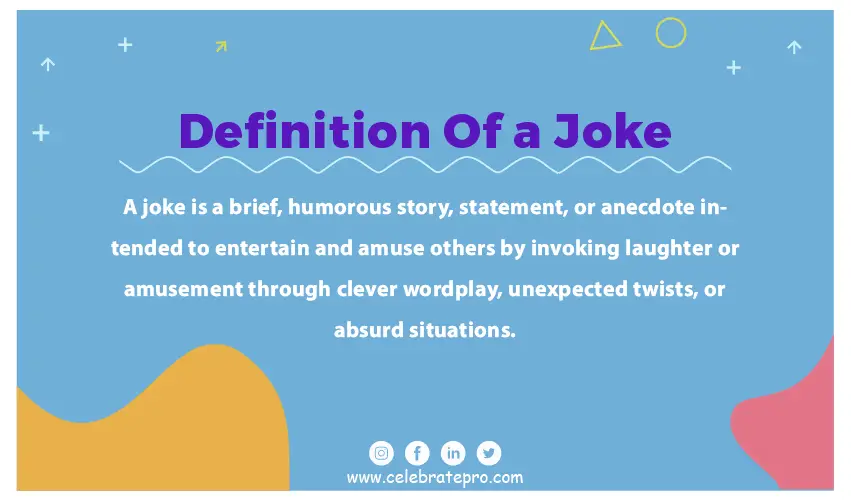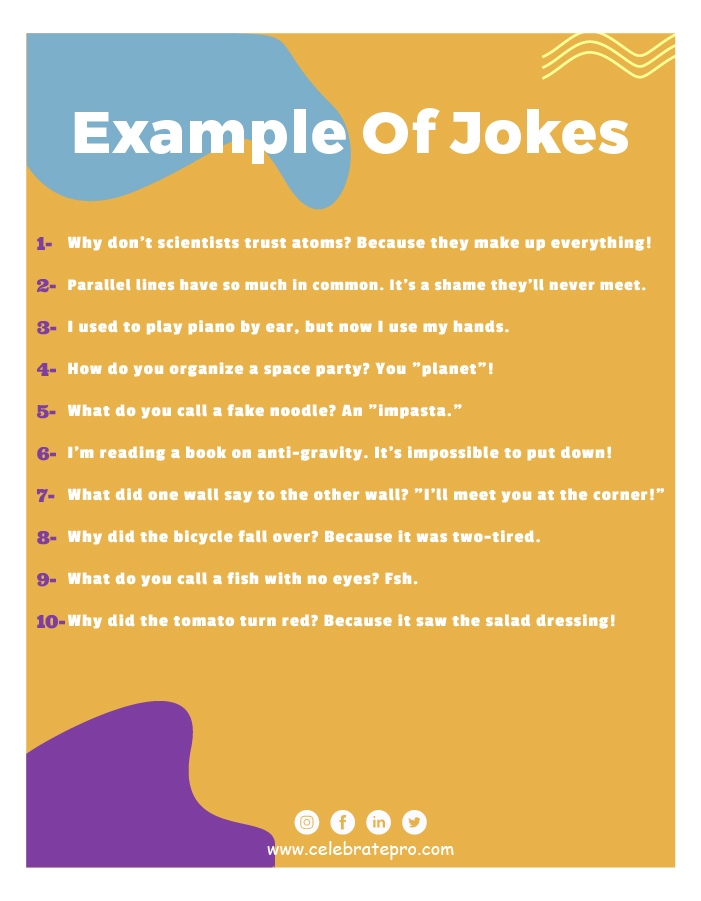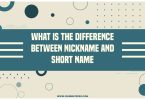Are you ready to embark on a journey into the world of humor? Brace yourself for a laughter-filled adventure as we delve into the realm of puns and jokes. In this article, we will explore the key differences between puns and jokes, uncovering their unique characteristics and understanding their impact on our daily lives. Get ready to have your funny bone tickled and your wit sharpened!
What is A Pun?
Let’s start our comedic expedition by understanding what exactly a pun is. A pun is a form of wordplay that exploits multiple meanings of a word or words that sound similar but have different meanings.
It’s a clever play on words that often results in a humorous or witty effect. Puns can be found in various forms, such as one-liners, riddles, or even as a punchline in a longer joke. They are a delightful way to showcase linguistic creativity and tickle our funny bones.

What Are Jokes?
Now that we have a grasp on puns, let’s move on to jokes. Jokes are humorous narratives or anecdotes that are designed to entertain and amuse. They often involve a setup and a punchline, with the punchline delivering the comedic twist or surprise.
Jokes can take various forms, including one-liners, knock-knock jokes, or even longer stories. They rely on clever wordplay, absurd situations, or unexpected twists to generate laughter and amusement.

Different Types Of Puns:
- Homographic Puns: These puns rely on words that are spelled the same but have different meanings. Here’s an example: “I used to be a baker, but I couldn’t make enough dough.”
- Homophonic Puns: These puns use words that sound the same but have different meanings. For instance: “I’m reading a book about anti-gravity. It’s impossible to put down!”
- Homonymic Puns: These puns involve words that are both spelled and pronounced the same but have different meanings. Here’s an example: “I’m addicted to brake fluid, but I can stop whenever I want.”
- Compound Puns: These puns involve combining two or more words to create a humorous effect. For example: “I’m reading a book about mazes. It’s a-maze-ing!”
- Visual Puns: These puns rely on visual cues or play on words using images or symbols. Here’s an example: a picture of a bee with the caption “What’s the buzz?”
- One-Liner Puns: These puns are short and often rely on wordplay or double meanings. For instance: “I used to be a baker, but I couldn’t make enough dough.”
- Idiomatic Puns: These puns involve idiomatic expressions or phrases. Here’s an example: “I’m reading a book on reverse psychology. Don’t buy it!”
- Linguistic Puns: These puns play with the structure or meaning of language itself. For example: “Time flies like an arrow; fruit flies like a banana.”

Different Types Of Jokes:
- Pun Jokes: These jokes play on words or use double meanings to create humor. For example: “I used to be a baker, but I couldn’t make enough dough.”
- One-Liner Jokes: These jokes are short and snappy, often relying on clever wordplay or unexpected punchlines. For example: “Why don’t scientists trust atoms? Because they make up everything!”
- Knock-Knock Jokes: These jokes follow a specific format where one person initiates the joke with “Knock, knock,” and the other person responds with “Who’s there?” The joke then continues with a humorous play on words. For example: “Knock, knock.” “Who’s there?” “Lettuce.” “Lettuce who?” “Lettuce in, it’s cold out here!”
- Dad Jokes: These jokes are known for their cheesy and often predictable humor. They are usually family-friendly and involve puns or wordplay. For example: “Why don’t skeletons fight each other? They don’t have the guts!”
- Blonde Jokes: These jokes often play on stereotypes about blondes, although they can be applied to any group. They typically involve portraying blondes as less intelligent or making humorous observations about their behavior. For example: “Why did the blonde stare at the can of orange juice? Because it said ‘concentrate’!”
- Dark Humor Jokes: These jokes touch on sensitive or taboo subjects, often making light of them. They can be controversial and are not suitable for all audiences. For example: “Why don’t skeletons fight each other? They don’t have the guts! Unless it’s a rib-tickling contest.”
Difference Between Puns And Jokes:
| Puns | Jokes |
|---|---|
| Puns are a specific type of wordplay that relies on multiple meanings or similar sounds of words. | Jokes are a broader category of humor that can include puns but also encompass other forms of comedic storytelling. |
| Puns often involve a play on words, exploiting the double meanings or similar sounds of different words. | Jokes can be based on wordplay, situational humor, absurdity, or other comedic techniques. |
| Puns are usually short and concise, often consisting of a single sentence or phrase. | Jokes can vary in length and structure, ranging from one-liners to longer stories or setups with punchlines. |
| Puns are often clever and require the listener to make a connection between the different meanings or sounds of words. | Jokes can rely on surprise, irony, or unexpected twists to create humor. |
| Puns are typically used to elicit a quick, witty response or to add a humorous touch to a conversation or written text. | Jokes are often told or performed with the intention of entertaining an audience and generating laughter. |
| Puns can be found in various forms of media, such as books, advertisements, and social media posts. | Jokes are commonly shared in stand-up comedy routines, comedy clubs, TV shows, movies, and online platforms. |

Difference Between Puns And Wordplay
| Puns | Wordplay |
|---|---|
| Puns are a specific type of wordplay that relies on multiple meanings or similar sounds of words. | Wordplay is a broader term that encompasses various linguistic techniques used to create humor or clever effects with words. |
| Puns often involve a play on words, exploiting the double meanings or similar sounds of different words. | Wordplay can involve puns, but it can also include other techniques such as rhymes, alliteration, spoonerisms, anagrams, and more. |
| Puns are usually concise and focused on creating a humorous effect through clever word connections. | Wordplay can be used for various purposes, including humor, creating memorable phrases, emphasizing certain ideas, or adding a playful tone to a conversation or text. |
| Puns often require the listener to make a connection between the different meanings or sounds of words to understand the humor. | Wordplay can be more straightforward, relying on the use of linguistic devices to create a clever or witty effect without necessarily requiring the same level of word connection as puns. |
| Puns are commonly used in jokes, riddles, and witty remarks to elicit laughter or amusement. | Wordplay can be found in a wide range of contexts, including literature, advertising, poetry, song lyrics, comedy, and everyday conversations. |
| Puns are a specific subset of wordplay that focuses on the humorous use of words and their multiple meanings or sounds. | Wordplay encompasses a broader range of linguistic techniques and creative use of language beyond just puns. |
Difference Between Puns And Dad Jokes
| Puns | Dad Jokes |
|---|---|
| Puns are a specific type of wordplay that relies on multiple meanings or similar sounds of words to create a humorous effect. | Dad jokes are a type of joke characterized by their corny, cheesy, and often predictable nature. |
| Puns often involve a play on words, exploiting the double meanings or similar sounds of different words. | Dad jokes can include puns, but they can also rely on other comedic techniques such as wordplay, irony, or absurdity. |
| Puns are usually short and concise, often consisting of a single sentence or phrase. | Dad jokes can vary in length, ranging from one-liners to longer stories or setups with punchlines. |
| Puns are often clever and require the listener to make a connection between the different meanings or sounds of words. | Dad jokes are intentionally corny and often rely on simple, obvious humor that elicits groans or eye-rolls rather than genuine laughter. |
| Puns can be found in various forms of media, such as books, advertisements, and social media posts. | Dad jokes are commonly associated with fathers or father figures and are often shared in casual conversations, family gatherings, or online platforms. |
| Puns can be used in a variety of contexts and by people of all ages. | Dad jokes are typically associated with a specific style of humor that is often attributed to dads, hence the name “dad jokes.” |
The best Example Of Puns
- I used to be a baker, but I couldn’t make enough dough.
- I’m reading a book about anti-gravity. It’s impossible to put down!
- I’m friends with all the planets, but I have a special bond with Jupiter. We just have great chemistry!
- I was going to tell a joke about time travel, but you guys didn’t like it.
- I’m on a seafood diet. I see food, and I eat it!
- I’m reading a book about mazes. It’s so confusing, I can’t put it down!
- I used to be a baker, but I couldn’t make enough dough.
- I’m friends with all the planets, but I have a special bond with Jupiter. We just have great chemistry!
- I was going to tell a joke about time travel, but you guys didn’t like it.
- I’m on a seafood diet. I see food, and I eat it!
- I’m reading a book about mazes. It’s so confusing, I can’t put it down!
- I used to be a baker, but I couldn’t make enough dough.
- I’m friends with all the planets, but I have a special bond with Jupiter. We just have great chemistry!
- I was going to tell a joke about time travel, but you guys didn’t like it.
- I’m on a seafood diet. I see food, and I eat it!
Best Example Of Jokes
- Why don’t scientists trust atoms? Because they make up everything!
- Why don’t skeletons fight each other? They don’t have the guts!
- What do you call a fish wearing a crown? King Neptune!
- Why did the scarecrow win an award? Because he was outstanding in his field!
- Why don’t eggs tell jokes? Because they might crack up!
- What do you call a bear with no teeth? A gummy bear!
- Why did the bicycle fall over? Because it was two-tired!
- What do you call a snowman with a six-pack? An abdominal snowman!
- Why don’t scientists trust atoms? Because they make up everything!
- Why don’t skeletons fight each other? They don’t have the guts!

Best Puns For Kids
- Why did the scarecrow win an award? Because he was outstanding in his field!
- What do you call a bear with no teeth? A gummy bear!
- Why did the bicycle fall over? Because it was two-tired!
- What do you call a snowman with a six-pack? An abdominal snowman!
- Why don’t eggs tell jokes? Because they might crack up!
- What do you call a fish with no eyes? Fsh!
- Why did the tomato turn red? Because it saw the salad dressing!
- What do you call a dinosaur that is sleeping? A dino-snore!
- Why did the math book look sad? Because it had too many problems!
- What do you call a pig that knows karate? A pork chop!
- Why did the golfer bring two pairs of pants? In case he got a hole in one!
- What do you call a cow with no legs? Ground beef!
- Why did the banana go to the doctor? Because it wasn’t peeling well!
- What do you call a bear with no ears? B!
- Why did the math book look sad? Because it had too many problems!
Best Puns For Adults
- I used to be a baker, but I couldn’t make enough dough.
- I’m reading a book about anti-gravity. It’s impossible to put down!
- I was going to tell a joke about time travel, but you guys didn’t like it.
- I’m on a seafood diet. I see food, and I eat it!
- I’m reading a book about mazes. It’s so confusing, I can’t put it down!
- Why don’t scientists trust atoms? Because they make up everything!
- Why don’t skeletons fight each other? They don’t have the guts!
- What do you call a fish wearing a crown? King Neptune!
- Why did the scarecrow win an award? Because he was outstanding in his field!
- Why don’t eggs tell jokes? Because they might crack up!
- What do you call a bear with no teeth? A gummy bear!
- Why did the bicycle fall over? Because it was two-tired!
- What do you call a snowman with a six-pack? An abdominal snowman!
- Why did the math book look sad? Because it had too many problems!
Jokes For Kids
- Why don’t skeletons fight each other? They don’t have the guts!
- What do you call a bear with no teeth and no legs? A gummy worm!
- Why did the scarecrow win an award? Because he was outstanding in his field!
- What do you call a snowman with a six-pack? An abdominal snowman!
- Why did the bicycle fall over? Because it was two-tired!
- What do you call a fish with no eyes? Fsh!
- How do you organize a space party? You planet!
- What do you call a dinosaur that is sleeping? A dino-snore!
- Why did the math book look sad? Because it had too many problems!
- What do you call a bear with no ears? B!
- Why did the golfer bring two pairs of pants? In case he got a hole in one!
- What do you call a bear that’s caught in the rain? A drizzly bear!
- Why did the tomato turn red? Because it saw the salad dressing!
- What do you call a bear with no teeth? A gummy bear!
- Why don’t scientists trust atoms? Because they make up everything!
Jokes For Freinds
- Why don’t scientists trust atoms? Because they make up everything!
- What did one wall say to the other wall? I’ll meet you at the corner!
- Why don’t skeletons fight each other? They don’t have the guts!
- What do you call a fake noodle? An impasta!
- Why did the scarecrow win an award? Because he was outstanding in his field!
- How does a penguin build its house? Igloos it together!
- Why did the bicycle fall over? Because it was two-tired!
- What do you call a bear with no teeth? A gummy bear!
- Why don’t seagulls fly over the bay? Because then they would be bagels!
- What do you call a snowman with a six-pack? An abdominal snowman!
- Why did the tomato turn red? Because it saw the salad dressing!
- How do you organize a space party? You planet!
- What do you call a bear with no ears? B!
- Why did the golfer bring two pairs of pants? In case he got a hole in one!
- What do you call a bear that’s caught in the rain? A drizzly bear!
Purpose and Impact of Puns and Jokes
Puns and jokes serve various purposes in our lives. They act as social icebreakers, helping us connect with others through shared laughter. Humor, in the form of puns and jokes, can also alleviate stress, improve mood, and create a positive atmosphere.
Additionally, they can be used as persuasive tools, making complex ideas more accessible and memorable. Puns and jokes have the power to entertain, engage, and leave a lasting impact on our daily interactions.
Cultural and Language Variations in Puns and Jokes
- Cultural References: Puns and jokes often rely on cultural references that may not be universally understood. Humor that is specific to a particular culture may involve wordplay, idioms, or references to local customs, traditions, or historical events. These cultural nuances add depth and richness to the humor but may require some background knowledge to fully appreciate.
- Language-Specific Wordplay: Puns and jokes heavily depend on the intricacies of language. Different languages have their own unique wordplay techniques, such as homophones, homonyms, or puns that are specific to that language. Translating puns and jokes between languages can be challenging, as the humor may not carry over due to linguistic differences.
- Regional Dialects: Within a language, regional dialects can also influence the humor. Certain puns or jokes may be more prevalent or well-received in specific regions due to the dialect’s particular vocabulary, pronunciation, or cultural context. Understanding these regional variations allows for a deeper appreciation of the humor within a specific community.
- Humor Styles: Different cultures have distinct humor styles. Some cultures may prefer subtle and dry humor, while others may enjoy slapstick comedy or wordplay-driven jokes. Recognizing and appreciating these variations in humor styles can help bridge cultural gaps and foster cross-cultural understanding.
Conclusion
In conclusion, puns and jokes are two sides of the same hilarious coin. Puns showcase linguistic creativity and wordplay, while jokes entertain through narratives and comedic timing. Understanding the differences between puns and jokes allows us to appreciate the diverse forms of humor that exist.
So, the next time you encounter a pun or hear a joke, embrace the laughter and let it brighten your day. Remember, humor knows no boundaries, and it’s a universal language that connects us all. Now, go forth, armed with wit and laughter, and explore the endless possibilities of humor!



